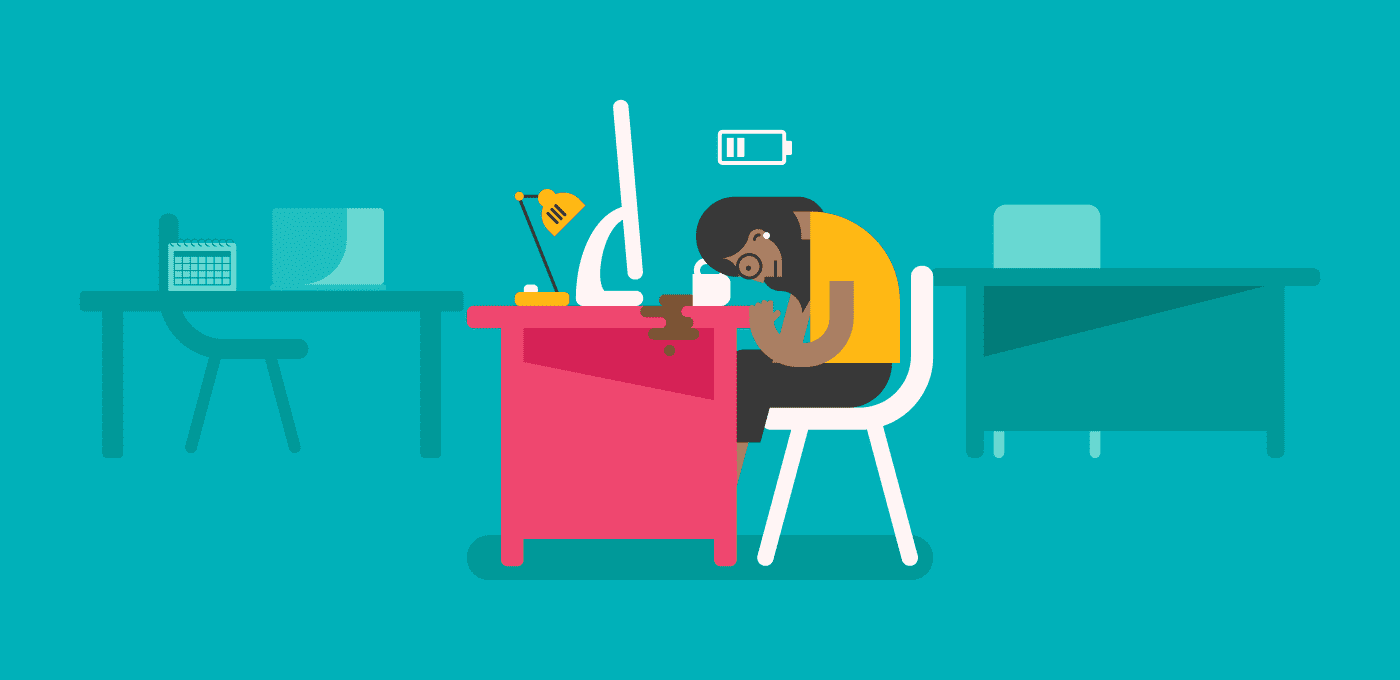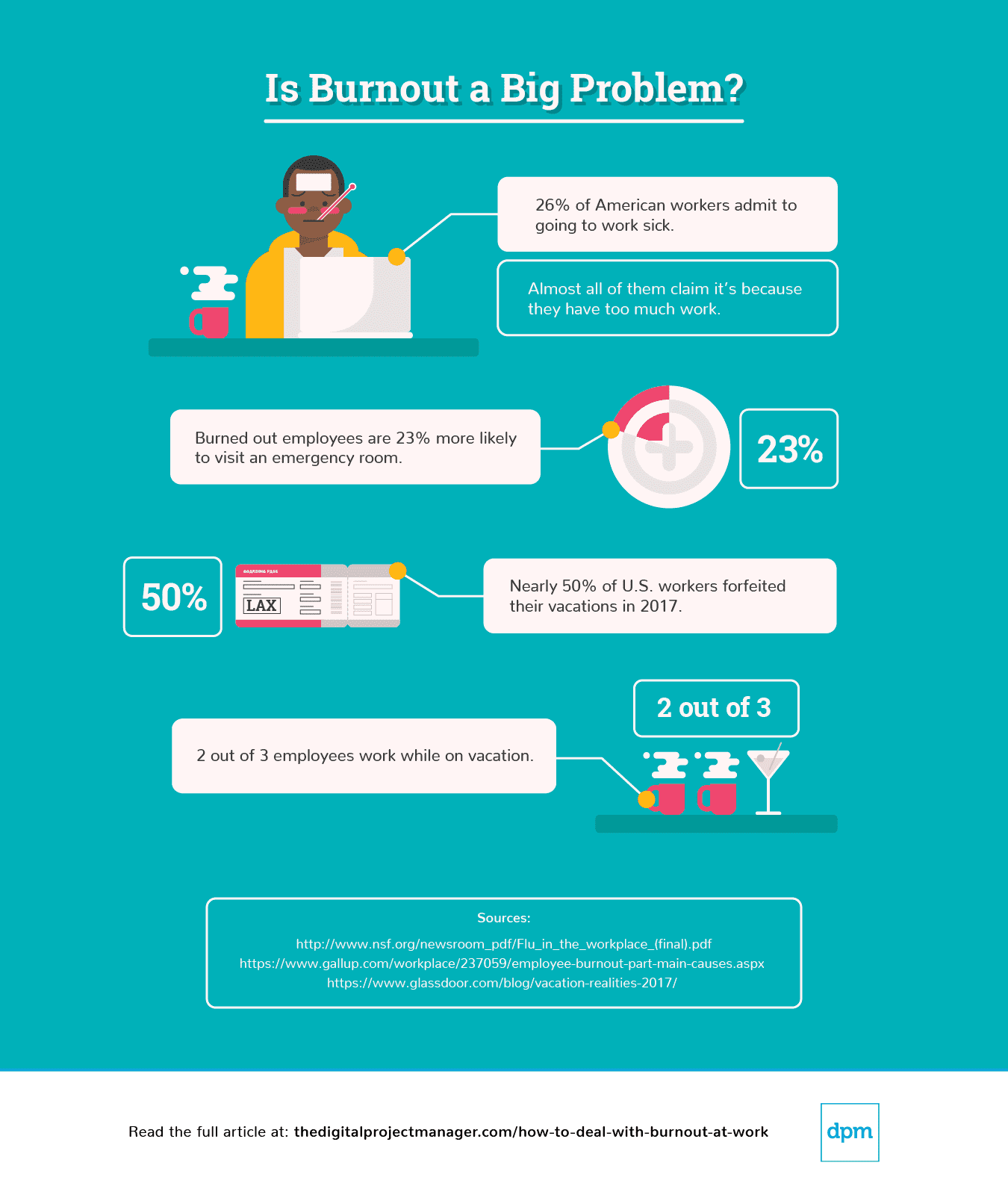Feeling apathetic and strung out on the job, or like you might want to quit? Employee burnout is a big issue in digital project management simply because of the type of work we do. In this post, I talk about personal experience with burnout, and explain how to deal with burnout at work as a PM.
A Personal Story About Work Burnout
I’m a little embarrassed to admit that I have spent too many years (ok…almost all of them) thinking that long hours and extra work will make my career. And maybe it has in some ways, but I didn’t realize the toll it has also taken.

2017 was an especially tough year. I gained 20 pounds, I worked in an unhealthy environment (for me at least), had a panic attack, and was becoming a not-so-nice person at home. Looking at it now, those were obvious signs of physical stress. But at the time I wasn’t ready to acknowledge it.
Then, something changed. While it would make for a nice story to say that I came to a self realization to take care of myself, that’s not what happened. Instead, during a week in June, I (along with a couple of coworkers) was laid off and sent home.
I was handed a sh*t deal and an amazing opportunity all in one. And, for once in my life, I took advantage of that moment and started to address my burnout. While I have a ways to go, I am making choices to reduce job stress: to balance my workload and only take on work that I enjoy, with people I like. Some weeks I succeed and some need improvement, but at least I am heading in the right direction.
Burnout In Project Management

Where does that leave everyone else? Studies show that two-thirds of full-time workers experience burnout at their job and, I strongly believe our Digital PM community is at a high risk of this path.
Other project managers share my concern for burnout. Here’s what Claire Harrington, a Delivery Team Manager and member of The DPM Membership community, had to say about burnout in project management:
“I think the more communication tools we have, the higher the expectations are for work getting done. Since we’re in a world where anyone can be reached 24/7, it can feel like you need to work 24/7 to be successful—which can definitely contribute to high stress and burnout.
I think [the issue of burnout] is very large and something that needs to be taken seriously. I’ve seen a lot of really great PMs’ time be mismanaged, causing them to leave the profession altogether. When you’re PM you are an extremely key player on projects so it can feel like a lot falls on your shoulders[…]”
By nature of our role, we are the matriarchs and patriarchs of our teams. We take care of all the things that our clients need, our team’s request and the projects require. At the same time, we often get overlooked when it comes to care and attention within our organizations. Our role is more often than not considered less valuable, shown in our pay, how people hire this role, the responsibility it is given, and more. I am not trying to start a rant here but when you hear more often than not that anyone can be a PM, it’s an important factor to consider.
So maybe you work at an organization that doesn’t quite know what to do with a good PM. Maybe the agency demands everyone to work long hours and provides a toxic environment. It is also possible that your DNA is a bit off (like myself) and think that you can do it all if you just keep swimming.
No matter how we got into this situation, you are the only person that can get yourself out of it. And, while I don’t know you personally, I think it’s time to make a change because I’m pretty sure you’re worth it. The first step to recovering from burnout is to identify your symptoms so you can start making the right changes.
What Are The Signs Of Burnout?
All too often, the symptoms of burnout are things that we shrug off as normal life stress, and not as the harmful symptoms of exhaustion that they truly are. If every morning you’re asking yourself, “Why do I have no energy?”, or going through each day emotionally drained and feeling exhausted, these are sure signs that you’re burning out. Sometimes, though, it’s hard to acknowledge—no one wants to burn out, and so we tend to ignore the signs.
What is burnout, exactly?
Here’s some insight from other project managers who’ve had to learn how to deal with burnout at work—see if you can find any parallels with your work life. Maybe you’re ignoring these not-to-obvious signs of exhaustion:
Researchers have identified three main types of symptoms for burnout:
- Exhaustion: no energy, poor memory, bad sleep, get sick often;
- Alienation: isolation, negative perspective, neglect yourself, easily agitated;
- Reduced Performance: missing deadlines, becoming less engaged, procrastination, inability to concentrate.
Claire from our DPM Slack channel provided some additional insight for sensing when you’re close to burning out:
“A big sign for me is I realized I haven’t had time to think strategically about big picture or ideas. If I cannot carve out some time for this that means there is too much on my plate. Another sign is that it gets harder and harder for me to get excited about the work I’m doing.”
Having one or two of these signs here and there is a normal part of life—we all have bad days. When you start recognizing many of these symptoms and experiencing them for an elongated period, you might be looking at burnout. Take a look look at your feelings and behaviors. Is this starting to echo your life?
In some cases, rapid organizational growth can lead to burnout—more here.
Simple Steps: How To Deal With Burnout At Work
So you acknowledge that you are at (or past) the point of burnout—and you’re ready for a change. It’s not going to be easy, but it’s something that you can do. Trying to get motivated while starting at a place of mental exhaustion is no easy task. If you’re in that space right now, know that you’re on the right path and that it will get better!
Here are the steps to follow in order to heal from burnout syndrome, along with some advice on how to avoid burnout in the first place down the road.
1. Gain Control Over Your Time
The first thing you should ask yourself is; do you control your time? Most likely not and honestly, it’s probably your own fault. We have gotten into a bad habit of planning around everyone else’s needs and schedules. At what point did we decide that our time as project managers was less valuable than others? Until we learn how to stop time (which I have always wanted as my superpower), we need to learn how to respect our time. Here are some ways we can do it.
Schedule Meetings Based On Your Availability As Well As The Rest Of Your Team
How many times have you found yourself squeezing meetings into the day in order to keep the project moving forward or work around a developer’s schedule? If there isn’t time in your schedule, there just isn’t. The project won’t go off the rails waiting a couple more days.
Take Well Deserved Breaks
Take a quick walk every couple of hours and leave your desk for lunch 3 days a week. I know that sounds silly but so many of us stay at our desks to eat because it’s the only quiet time we get all day. Staying put isolates you from the team and doesn’t give you those much needed mental breaks.
Book Work Time Into Your Schedule And Never Move It
Have you ever sat down at 4 pm and got excited to see people leave so you can finally get your work done? I remember that feeling, especially during the holiday break time. Clearly, this is not a healthy approach, so we need to plan work time into our schedule. Make sure you have two, 3-4 hour uninterrupted work periods a week. You should NEVER delete them or move them to the following week. Also, allow yourself 30 minutes in between meetings to prep and follow-up as needed.
Post A “Do Not Disturb” Sign
During your work times, you shouldn’t be bothered, so set snooze on Slack and place a sign at your desk signifying that you are unavailable right now. After all, if developers need focused time, don’t you deserve it too? If people aren’t respecting the barrier (including your boss), work from home for a day or hit a local coffee shop.
2. Create Work/Home Boundaries
Next we need to look at the boundary lines between work and our personal life. This can be hard to accomplish when we work in an industry that demands long hours and expects (if not demands) 24 hour access to our time. We want to be available to our team and clients when they need us but the truth is, we end up creating expectations. We send a message that we are available to help at any time. The good news is, we can always reset relationships and draw new lines.
While there are many distinct lines we can create, there are a couple you can get started with. (Or listen to our podcast episode with Sarah Hoban on setting boundaries vs quiet quitting here)
Leave Your Work At Work
Whether it’s paperwork, emails or your physical computer, don’t touch or open up anything after your workday is done. Now, we all know that things can get busy once in while and sites can go down, but stay at work and finish up. Don’t bring it home. I assure you, no one is going to die from not getting your email at 11:58 pm.
Take Personal/Work Days
If you work in an office; work from home once a week. It will give you a chance to complete tiny house tasks (like the dreaded laundry) while sitting comfortably in your sweats. You can use the hour you saved by not driving into the office on personal tasks. The break from the office will help you feel refreshed.
Don’t Come To Work Sick
Now I know this seems a bit obvious but you can’t say you haven’t done it before. In fact, 26% of American workers admit to going to work sick. And almost all of them claim it’s because they have too much work. What’s more, burned-out employees are 23% more likely to visit an emergency room. I don’t know about you, but I don’t have time to check-in at an emergency room, so take a break and rest up. Your body is telling you to!
Use Your Vacation Regularly
Did you know that nearly 50% of American workers forfeited their vacations in 2017 and 2 out of 3 employees work while on vacation? I’m not judging, as I have been guilty of both over the years, but you need to take a vacation, and frequently. Don’t pile everything up for the end of the year because you won’t have time to take it. And, since studies show that spending money on experiences improves your mental health, plan something fun to do like a concert, spa day, or a mini-trip to see a friend.
It's also important to make yourself redundant for instances like these.
Finally, Schedule Personal Time Around Work Trips And Conferences
You don’t have to travel to an amazing location only to be stuck in a hotel ballroom or office the entire time. Add a day at the top or tail of your trip to enjoy a new place.
3. Invest In Yourself
While we are busy taking care of others and our projects, we forget to take care of ourselves—no wonder we’re burning out! That’s a problem because it is up to us to invest in our career and growth. In order to strengthen yourself and our overall community, that needs to change. So how do we do this?
It Starts With Taking Care Of Our Health
Yep, that means eating the green stuff and hitting the gym. It also means that we need the right amount of sleep each night. Did you know that Jeff Bezos makes sure that he has 8 hours of sleep? In fact he says that it’s his responsibility to his investors and critical to making quality decisions. Now if a billionaire who currently makes most of the world’s decisions can fit in 8 hours a night, we certainly can.
Give Yourself Think Time
Microsoft Founder and chairman Bill Gates started Think Week years ago in order to allow him time to reflect and ponder the future of technology. Since that time, there have been varying takes on this practice that leaders have adopted. I think that each of us can find 2 hrs every other week to reflect and grow. This will allow you to clear your mind, improve your skills, and stay focused on where you are going with your career.
Surround Yourself With Positivity
You deserve a positive environment with healthy co-worker relationships. I recently attended a conference where I heard too many stories about bad bosses and miserable companies. If you can honestly answer that you are not contributing to the toxicity, then make a change. This might be a reset of your perspective and attitude, a physical adjustment, or a new job.
Stay Connected With The Community
It is important to both learn from those around you and give back to those that are new to our community. Find time for coffee or a meet-up once a month.
How To Get Started Dealing With Burnout
Where to start? There are lots of ideas above, and it would be overwhelming to do at once. Therefore, start small and pick one item to focus on in the first month. Make sure it abides by S.M.A.R.T Goal guidelines so that there’s no gray area around your success. Tell your coworkers so they hold you accountable and respect your boundaries. Make sure that you start with a fresh attitude to give the change a chance.
Just over a year ago I made a decision to start addressing my burnout. For me that meant setting work/life boundaries, engaging with positive agencies, drinking green smoothies, starting an exercise program, and of course, buying an oversized unicorn. I’m not perfect and I’m definitely still working on it, but I continue to commit to the fact that my health and happiness must be prioritized. I challenge you to join me!
Listen to our podcast episode about burnout with Lynn Winters here!


